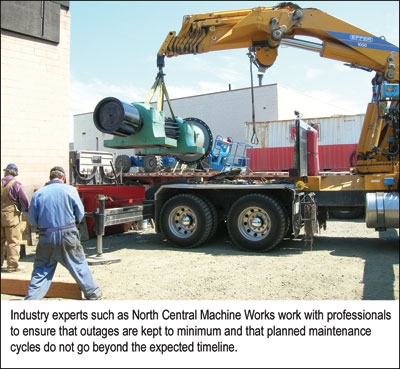
New Gear
Equipment
Sawmilling
Forgotten Profit
When markets get tight, maintenance is often the first budget cut. While understandable when cash flow falters, this strategy can jeopardize a low-cost producer’s ability to survive bad markets?
November 24, 2011 By Ed Sullivan
 When markets get tight
When markets get tight“Mills that are very proactive on the maintenance side are usually very successful, running at 95-98% uptime rates during peak periods,” says Dan Schreiner. “Those mills are very organized and diligent about their maintenance programs. Those with a reactive maintenance philosophy typically run at much lower rates.”
Schreiner is president of North Central Group, a Prince George, BC business that offers PM services that help reduce maintenance costs. NCG also offers field maintenance, equipment rebuilding, fabrication, manufacturing parts and machinery and equipment for pulp and paper, solid wood, mining, power generation, chemical and other plants. It works with such companies as Canfor, Pope & Talbot, Abitibi Bowater, Winton Global, West Fraser, Lakeland and more. With over 25 years experience, Schreiner suggests that those who plan maintenance programs in sawmills think twice before adopting policies that aim primarily at reduced costs and service intervals.
Postponing the inevitable
Unplanned shutdowns, emergency repairs and equipment rebuilding or replacement is inevitable, Schreiner points out. Yet, in the solid wood industry you will find mills located in the same region with profoundly different operating efficiencies because of fundamentally divergent maintenance philosophies.
“The lost production and consequential damage from reactive maintenance practices can be catastrophic. It often reflects a short-term approach to a cash need that can have long-term results by bringing a sawmill or panel plant down during strong market periods when they should be running flat out.”
Depending on the sector, uptime differences can run into millions of dollars annually, far exceeding any reasonable hope for savings on maintenance costs. What then, explains the differing philosophies?
In tight times like now, costs become an even more pronounced issue with many mills, says Schreiner. This may tempt management to put at least some maintenance on hold, or base vital equipment repairs on the lowest cost instead of the best long-term solutions.
“There are shops that specialize in quick turnaround and lower prices,” he explains, “and they have a place. Some mills that are focused on the “$1.95 is less than $2.00 approach” feel that they have no other choice than to go with the lowest price, but there are trade-offs in workmanship versus cost over the long run. When the equipment is needed, a premature failure often takes more time, lost production and emergency service charges to get back up and running again. That’s a risk that usually isn’t worth the short term savings.”
A secondary failure could also worsen a maintenance situation considerably, Schreiner says. “This sometimes occurs if equipment was not serviced or repaired correctly and causes problems downstream.”
As an example, Schreiner cites a project recently completed at North Central Machine’s on-site shop. The project involved repairing knive holders on a chipper, a job that sometimes gets a quick fix to ensure rapid turnaround and low costs. “We understand that these parts are subject to high-impact loads so we perform non-destructive testing on them” he explains. “We check for microscopic cracks, and if any are found, we deal with it. In servicing these parts, you often see metal fatigue causing cracks in rotary equipment where components turn at high RPM. That’s significant because when you lose a knife in a chipper, it will destroy another dozen knives, anvils and clamp bars. Safety is also key. Worker deaths have resulted from these types of failures. This is the type of repair work that may seem minor on the surface, but requires expertise.”
PM can go even deeper, to the root cause of a failure. “There are companies in the sawmill, pulp & paper, OSB and mining industries that have taken a reliability centered maintenance (RCM) approach. When it comes to root cause analysis, they focus on getting rid of equipment that continues to fail.” says Schreiner. “Part of that is understanding how those failures contribute to downtime and lost profits. Some organizations recognize that downtime due to equipment failures can often be prevented through good maintenance practices, resulting in a proven return on investment.”
Some of these companies recognized the need to change during downturns in their business sector. They invest time, manpower and money in areas like best practices, failure analysis, lubrication programs, RCM, and maintenance optimization to significantly reduce both maintenance costs and downtime.
“Experience in other industries can help the solid wood sector apply some of those technologies and capabilities to their mills. Until you find the root cause of failure and identify the mechanisms involved, you have a high risk of repeating the failure.”
And who can afford that today?
Ed Sullivan is a writer in Hermosa, CA, and wrote this for the North Central Group. www.ncmachineworks.com.
Print this page